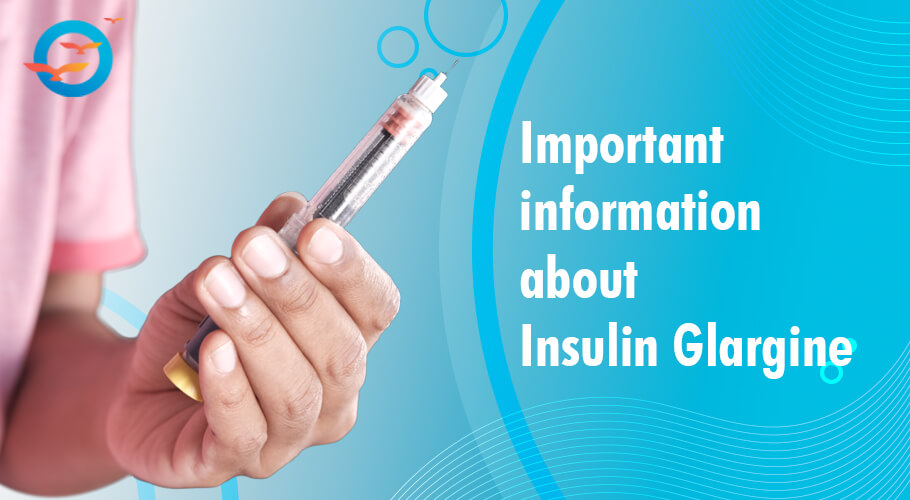Important information about Insulin Glargine- FFD

Type 1 diabetes is a condition where the body doesn’t produce insulin and thus blood sugar cannot be controlled by the body itself. In this case, insulin needs to be administered externally. Type 2 diabetics too need insulin when their bodies are unable to use insulin normally. For both these categories of diabetics, insulin glargine is used.
Type 1 diabetics need to supplement insulin glargine with short-acting insulin, whereas people with type 2 diabetes can use insulin glargine products with oral medication/s or another type of insulin.
The reason insulin glargine needs to be used with short-acting insulin is because it acts as a basal dose, in effect a manmade version of human insulin. It helps move sugar from the blood into body tissues where it is used for energy, and it restricts the production of sugar in the liver. However, when we eat our meals, the sudden influx of carbohydrates causes blood sugar to spike. An additional but quick-acting dose—known as bolus dose—is taken to counteract this effect and stabilize BSL.
Glargine Insulin Uses. Do’s and Don’ts
DO
- Follow the directions on the label carefully. If you have any doubts, talk to the pharmacist or your doctor.
- Dose and administration method must be as prescribed by your doctor, so ensure you know what supplies you need, i.e. needles, syringes, pens, etc. and maintain needed stocks
- When purchasing, double check the label to ensure you’ve been given the prescribed type of insulin.
- Rotate injection site with each dose, so you don’t inject in the same spot more than once every couple of weeks.
- Only inject insulin glargine subcutaneously; never inject it directly into a vein or muscle
DON’T
- Never use insulin glargine if you notice signs of hypoglycemia, viz. low blood sugar.
- Do not stop using insulin glargine simply because you think you’re well; talk to your doctor before making any change, be it dosage or switching to some other brand of insulin.
- Don’t administer without full understanding; if you need, ask the doctor to explain how to inject the same or how to use the pen.
- Do not use pre-used needles nor should you re-use or share syringes.
- Remove the needle from the insulin pen immediately after injecting and discard the needle and syringe properly, viz in a puncture-proof container.
- Do not dilute or mix insulin glargine products with any other type of insulin.
- Do not use insulin glargine if it is past expiry; it should not be colored, cloudy, or contains solid particles; ensure the product is clear and colorless.
- Do not use external insulin pump to administer insulin glargine
Tell your Doctor:
- If you’re suffering from any other medical condition, such as heart, liver, or kidney damage, or have suffered diabetes-related nerve damage.
- If you’re on any other medication.
- Of any allergies, you may suffer from, as insulin glargine products may contain ingredients you might be allergic to.
- If you’re pregnant, planning to become pregnant, or have delivered and are breastfeeding.
- If you’re going to have surgery inform the doctor/surgeon that you’re on insulin glargine.
- Of any change to your diet, exercise, or if you are experiencing excessive stress, as these factors affect your blood sugar and your insulin doses need to be adjusted accordingly.
Insulin glargine products cause changes in your blood sugar, so it is important to know symptoms of low and high blood sugar and the correct treatment for them
Insulin Glargine Side Effects
Like all prescription drugs, Insulin glargine products too can cause side effects. If any of these symptoms are severe or do not go away, you must inform your doctor
- Pain, swelling, redness at the injection spot
- Itching, rash all over the body
- Breathing problems like wheezing or difficulty in swallowing
- Excessively fast or erratic pulse rate
- Inexplicable sweating
- Problems with your vision
- Swollen eyes, lips or tongue
- General weakness, muscle cramps
- Sudden weight increase
- Swollen feet
Call your doctor if you notice these or any other sudden problems when using insulin glargine products
In the event of an overdose
Failure to use the correct dose, either through miscalculation or change in meal quantity/time/composition, or change in physical activity, can result in an overdose, which can cause hypoglycemia.
If you notice any symptoms of hypoglycemia such as weakness, cold sweats, etc. follow medical instructions for hypoglycemia. If symptoms are severe it falls to people around you to take action. To help them help you, ensure you carry a medical id and if possible glucagon kit. Also ensure you visit your doctor after any hypoglycemic attack—mild or severe. For more information on hypoglycemia, treatment and prevention, read our article Care to be taken while on insulin-understanding hypoglycemia.

